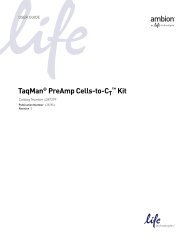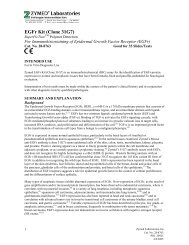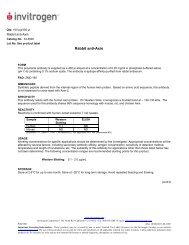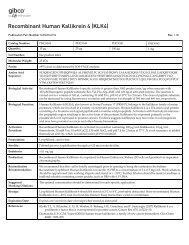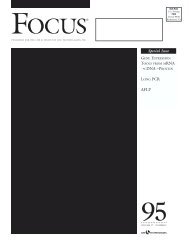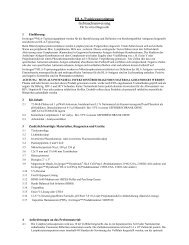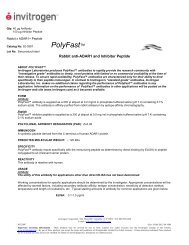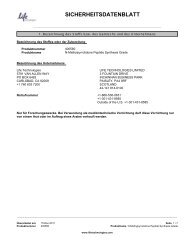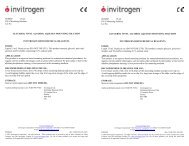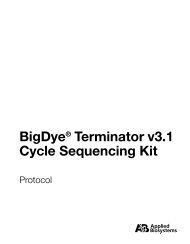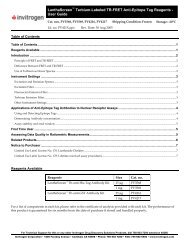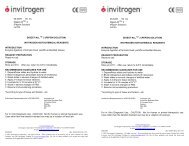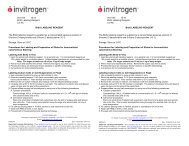pRc/RSV - Invitrogen
pRc/RSV - Invitrogen
pRc/RSV - Invitrogen
Create successful ePaper yourself
Turn your PDF publications into a flip-book with our unique Google optimized e-Paper software.
<strong>pRc</strong>/<strong>RSV</strong><br />
Version C<br />
171023<br />
28-0051<br />
U.S. Headquarters: European Headquarters:<br />
<strong>Invitrogen</strong> Corporation <strong>Invitrogen</strong> BV<br />
1600 Faraday Avenue De Schelp 12, 9351 NV Leek<br />
Carlsbad, CA 92008 The Netherlands<br />
Tel: (800) 955-6288 Tel: +31 (0) 594 515 175<br />
Fax: (760) 603-7201 Fax: +31 (0) 594 515 312<br />
E-mail: tech_service@invitrogen.com E-mail: tech_service@invitrogen.nl
<strong>pRc</strong>/<strong>RSV</strong><br />
Supercoiled Vector<br />
Catalog No. V780-20<br />
Contents<br />
<strong>pRc</strong>/<strong>RSV</strong>, 20mg of supercoiled vector, lyophilized in 10mM Tris-HCl, pH7.4, 1mM EDTA.<br />
TOP10F' bacterial strain, supplied as a stab.<br />
Reconstitute the vector in sterile water to a final concentration of 1mg/ml.<br />
Store the reconstituted vector at -20°C.<br />
Stabs should be stored at +4°C.<br />
Description<br />
<strong>pRc</strong>/<strong>RSV</strong> is a 5.2kb vector designed for high-level stable expression in eukaryotic hosts. The <strong>RSV</strong><br />
promoter has shown high-level expression in a wide range of mammalian cells. This vector will replicate<br />
episomally in cell lines that are latently infected with SV40 or which express the SV40 large T antigen (e.g.<br />
COS7). High-level stable and non-replicative transient expression can be carried out in most mammalian<br />
cells.<br />
Features<br />
Features-for eukaryotic expression<br />
• <strong>RSV</strong> LTR (Rous sarcoma virus long terminal repeat) promoter and enhancer which will express inserted<br />
genes from the first ATG codon (provided by insert).<br />
• Multiple cloning site polylinker<br />
• Bovine growth hormone (BGH) polyadenylation signal for polyadenylation of transcribed mRNAs<br />
• SV40 origin for transient episomal replication in cells expressing SV40 large T antigen<br />
• Neomycin resistance marker, expressed from the SV40 early promoter for the selection of stable<br />
transformants in the presence of G418<br />
Features for growth and maintenance in E.coli:<br />
• b-lactamase gene to confer ampicillin resistance<br />
• ColE1 origin of replication from pUC19 for high copy number growth<br />
• f1 origin for rescue of single-stranded DNA (for mutagenesis or single-strand sequencing)<br />
• Inverted BstX I sites for efficient cDNA library construction using <strong>Invitrogen</strong>'s non-palindromic cloning<br />
strategy<br />
Note: There is an ATG upstream from the Xba I and Apa I sites within the polylinker.<br />
E. coli Strains<br />
TOP10F' is provided for growth and maintainence of this plasmid. TOP10F' is a recombination negative strain<br />
designed for stable replication of high copy number plasmids. Since TOP10F' carries a F' episome, it is suitable for<br />
single strand phagemid rescue. This strain is provided as a convenience for those who do not have access to<br />
other E.`coli strains. Many E.coli strains are suitable for the growth of this vector including DH5aF', JM109, and<br />
INVaF'. In general, grow vectors containing inserts in E. coli strains which are recombination deficient (recA-).<br />
Instructions for growth of TOP10F' stab:<br />
Using a flame sterilized loop, streak from the TOP10F' stab onto LB agar plates supplemented with<br />
15mg/ml of tetracycline. Incubate the plates at 37°C overnight.<br />
On the following day, pick well-isolated, single colonies from these plates for the preparation of frozen<br />
stocks and competent cells.<br />
Any standard protocol for competent cell preparation and transformation is suitable for use with this strain.<br />
Genotype of TOP10F'<br />
F'{lacIqTn10(TetR )} mcrA D(mrr-hsdRMS-mcrBC) F80lacZDM15 DlacX74 deoR recA1 araD139 D(ara-leu)7697<br />
galU galK rpsL endA1 nupG<br />
Selected Genotype Explanations<br />
• recA1 is for increased stability of inserts, reducing recombination by 1000 fold.<br />
26-0026 C<br />
US Headquarters: European Headquarters:<br />
800-955-6288 2 +31 (0) 594 515 175
<strong>pRc</strong>/<strong>RSV</strong><br />
Supercoiled Vector<br />
Catalog No. V780-20<br />
• endA1 is for improved quality of minipreps.<br />
• hsdRMS eliminates cleavage of recombinant plasmid by the endogenous EcoR restriction system.<br />
• deoR: A mutation that has been found to improve plasmid transformations, particularly of large constructs (up<br />
to 66kb).<br />
• Carries the F' episome which is required for pili formation. F' is required for infection by helper phage (e.g.<br />
R408, M13K07) for rescue of single strand DNA from vectors containing f1 (M13) origins. Note that this F'<br />
carries the tetracycline resistance marker. For maintenance of the F', these cells must be plated on media<br />
containing tetracycline (15mg/ml).<br />
• The lac I q encodes lac repressor which enables repression of genes containing the lacO in the promoter<br />
region. In the presence of lac I q encoded repressor, such lacO containing genes remain silent until induction<br />
(de-repression)with IPTG.<br />
• LacZDM15 encodes a b-galactosidase (W-fragment) which has a N-terminal deletion of 146aa. The LacZDM15<br />
gene product is not functional alone but can be complemented by "a-complementation" by the a part (first<br />
146aa, encoded by Lac Za). The a part of b-galactosidase is usually encoded on a plasmid or phage (in trans)<br />
downstream of the IPTG inducible Lac promoter. a-complementation is the basis for blue-white screening. A<br />
functional b-galactosidase catalyzes the white –> blue reaction of the chromogenic substrate, X-gal, resulting in<br />
white "positive" and blue "background" colonies. Electrocompetent and chemically competent Top10F' cells<br />
are available from <strong>Invitrogen</strong> as follows:<br />
Catalog No. Description<br />
Efficiency Aliquots<br />
C665-55 Electrocompetent Top10F' 1 x 109 5 x 80ml<br />
C665-11 Electrocompetent Top10F' 1 x 109 10 x 80ml<br />
C665-03 Ultracomp chemically competent TOP10F' 1 x 108 5 x 300ml<br />
L1165-01 Library Size Transformation Kit 3 x 108 5 x 300ml<br />
Chemically competent TOP10F' (5 x 1ml)<br />
L1165-55 Library Size Electroporation Kit - TOP10F' 1 x 109 10 x 80ml<br />
(also includes chemically competent cells for test ligations) (5 x 300ml)<br />
Recommendations<br />
A protocol for the purification of single-stranded DNA has been provided. Several other protocols for this<br />
procedure may be found in references such as "Molecular Cloning" by Maniatis or "Current Protocols in<br />
Molecular Biology". There are two strains of helper phages recommended for this procedure, R408 (Cat#<br />
R568-01) and M13K07 (Cat# R137-01).<br />
Transfection of Mammalian Cells<br />
Many different methods for transfection of mammalian cells exist. Some of those are Calcium Phosphate,<br />
DEAE-Dextran or Liposome mediated, and electroporation. For stable transfections, the Calcium<br />
Phosphate method is the most widely used.<br />
<strong>Invitrogen</strong>'s Calcium Phosphate Transfection Kit is a simple and reliable method for transfection of almost<br />
any adherent cell type. <strong>Invitrogen</strong> also offers an electroporator which is ideal for mammalian<br />
electroporation of non-adherent cells, when used with a compatible power supply (not included). Please<br />
call for additional information on these products.<br />
Catalog No.<br />
Description<br />
K2780-01 Calcium Phosphate Transfection Kit 75 reactions<br />
S1650-02 ElectroPorator 1unit<br />
Calcium Phosphate Transfection (Wigler, M., Silverstein, S., Lee, L-S, Pellicer, A., Cheng, Y-C, and Axel,<br />
R. 1977).<br />
Electroporation (Chang, D.C, 1989), (Chu, G., Hayadawa, H., and Berg, P. 1987) and (Guide to<br />
Electroporation and Electrofusion 1992).<br />
26-0026 C<br />
US Headquarters: European Headquarters:<br />
800-955-6288 3 +31 (0) 594 515 175
<strong>pRc</strong>/<strong>RSV</strong><br />
Supercoiled Vector<br />
Catalog No. V780-20<br />
Neomycin (G418) Selection in Mammalian Cells<br />
Basis for selection:<br />
G418 blocks protein synthesis in mammalian cells by interfering with ribosomal function. It is an<br />
aminoglycoside, similar in structure to neomycin, gentamycin, and kanamycin.<br />
The bacterial aminoglycoside phosphotransferase (APH) gene is derived from Tn5. Expression in<br />
mammalian cells results in detoxification of G418.<br />
Selection conditions:<br />
G418 is available from Gibco/BRL. Use 100 to 800mg/ml of G418 in complete medium. G418 should be<br />
prepared in a highly buffered solution (e.g. 100mM HEPES, pH 7.3) so that the addition of the drug does<br />
not alter the pH of the medium.<br />
Varying concentrations of G418 should be tested as cells differ in their susceptibility to killing by G418.<br />
Different lots of G418 can have different potencies, causing many investigators to buy a large amount of<br />
one lot to standardize selection conditions. G418 concentration should be calculated using the amount<br />
of active drug (usually indicated on the label) so that variance is controlled.<br />
Cells will divide once or twice in the presence of lethal doses of G418, so the effects of the drug take<br />
several days to become apparent. Complete selection can take up to 3 weeks of growth in selective<br />
media.<br />
Protocols<br />
Preparation of Single-stranded DNA from <strong>Invitrogen</strong>'s Phagemids<br />
Infection with Helper Phage<br />
There are two strains of helper phage recommended, R408 (Cat# R568-01) and M13K07 (Cat # R137-<br />
01). When using M13K07 make sure that the helper phage was selected with Kanamycin to ensure<br />
retention of the proper phenotype.<br />
1. Inoculate 3.0ml of SOB media with 0.2ml of an overnight culture that is male-specific (contains the F'<br />
episome coding for pili production) and carries a plasmid that has the f1 or M13 ori allowing singlestranded<br />
rescue.<br />
2. Allow the inoculant to reach OD600 = 0.3 (approximately 40 minutes at 37°C) and infect with helper<br />
phage at an MOI (multiplicity of infection) of 20:1 (phage:cells).<br />
Note: When the OD600 = 0.3, there will be approximately 2.5 x 108 cells/ml.<br />
3. Grow for 6 to 8 hours at 37°C with vigorous shaking (at temperatures less than 34°C, the F-pilus is not<br />
produced and therefore does not allow helper phage infection).<br />
4. Pellet the cells at 2000 rpm for 10 minutes. If you need to store the rescued material, heat the<br />
supernatant to 60-70°C for 30 minutes to inactivate the bacterial cells (do not add chloroform). Phage<br />
are stable for long periods of time at 4°C.<br />
Purification of Single-stranded DNA<br />
There are several protocols for the purification of single-stranded DNA. The following is only one of<br />
several and produces high yields of single-stranded DNA for sequencing or mutagenesis.<br />
1. Transfer the supernatant to a fresh microcentrifuge tube. Treat the supernatant with 1mg/ml of<br />
RNase and 10mg/ml of DNase and then incubate at 37°C for 10 minutes.<br />
2. Add 1/4 volume of a solution of 3.5M ammonium acetate and 20% polyethylene glycol (MW 6000).<br />
3. Incubate the solution on ice for at least 10 minutes. Microcentrifuge the tube for 5 minutes.<br />
26-0026 C<br />
US Headquarters: European Headquarters:<br />
800-955-6288 4 +31 (0) 594 515 175
<strong>pRc</strong>/<strong>RSV</strong><br />
Supercoiled Vector<br />
Catalog No. V780-20<br />
4. Pour off the supernatant (there should be a small pellet) and wipe the inside of the tube, being<br />
careful not to disturb the pellet.<br />
5. Resuspend the pellet in 200ml of TE buffer (10mM tris, pH 8.0, 1mM EDTA) and vortex the tube<br />
vigorously to complete resuspension.<br />
6. Add 200ml of buffer saturated phenol (neutralized with 0.1M Tris, pH 8.0), vortex the tube vigorously<br />
for 30 seconds and spin in a microcentrifuge for 5 minutes.<br />
7. Using a pulled pasteur pipette, carefully remove the bottom organic layer and discard. Save the<br />
aqueous layer and the interphase in the original tube. Much of the DNA can be bound to proteins<br />
at the interphase. Repeat this phenol extraction one more time.<br />
8. Extract one time with 200ml phenol-chloroform (1:1) using the same technique as in Steps 6 and 7.<br />
Save the aqueous and the interphase in the original tube.<br />
9. Extract twice with 200ml of chloroform as before. On the final extraction, transfer the aqueous (top)<br />
layer to a fresh microcentrifuge tube leaving the interphase behind.<br />
10. Add 150ml of 7.5M ammonium acetate and 1ml of 95% ethanol. Mix the solution thoroughly.<br />
11. Incubate the solution at -70°C for 30 minutes then spin in a microcentrifuge for 10 minutes at room<br />
temperature.<br />
12. Pour off the supernatant and add 1ml of cold (-20°C) 95% ethanol. Spin the tube in a microcentrifuge<br />
for 5 minutes.<br />
13. Pour off the supernatant and vacuum the tube dry. There may not be a visible pellet but rather a haze<br />
on the side of the tube, this is the DNA.<br />
14. Resuspend the DNA in 10-20ml of 10mM Tris HCl, pH 7.5, and store at -20°C.<br />
15. Run 1-5ml of the DNA on a 1% agarose gel. Both the phage and the phagemid DNA should be<br />
visible and roughly at a 1:1 ratio. To calculate the amount of single-stranded DNA, determine the<br />
OD260, calculate the amount of total DNA and estimate the percentage that is single-stranded from<br />
the agarose gel.<br />
16. A faint band may appear below the major DNA bands, indicating single-stranded DNA that is nicked<br />
and therefore linear. This band will get more intense upon storage and subsequent freezing and<br />
thawing of the DNA. It is difficult to detemine where the helper phage will run on a 1% agarose gel,<br />
but it is typically between 4 and 6kb. The yield of single-stranded phagemid DNA is less than with<br />
clones in an M13 vector. Adjustments should be made for amounts required for sequencing.<br />
References<br />
Calcium Phosphate Transfection:<br />
Wigler, M., Silverstein, S., Lee, L-S, Pellicer, A., Cheng, Y-C, and Axel, R. (1977) "Transfer of Purified<br />
Herpes Virus Thymidine Kinase Gene to Cultured Mouse Cells." Cell 11: 223-232.<br />
Neomycin Selection:<br />
Southern, P.J. and Berg, P (1982) "Transformation of mammalian cells to antibiotic resistance with a<br />
bacterial gene under control of the SV40 early region promoter." J. Mol. Appl. Gen. 1:327-341.<br />
Current Protocols in Molecular Biology (1990) ed. Ausubel, F.M., R. Brent, R.E. Kingston, D.D. Moore,<br />
J.G. Seidman, J.A. Smith, K.Struhl. pub. Greene Publishing Associates and Wiley-Interscience.<br />
This is a large two volume set)<br />
Molecular Cloning, A Laboratory Manual, 2nd Edition. (1989) Sambrook, Futsch, Maniatis. Cold Spring<br />
Harbor Laboratory Press. This is a three volume set.<br />
26-0026 C<br />
US Headquarters: European Headquarters:<br />
800-955-6288 5 +31 (0) 594 515 175
<strong>pRc</strong>/<strong>RSV</strong><br />
Supercoiled Vector<br />
Catalog No. V780-20<br />
<strong>RSV</strong> LTR Promoter References:<br />
Gorman, C.M., Merlino, G.T., Willingham, M.C., Pastan, I., Howard, B.H., (1982) The Rous Sarcoma Virus<br />
Long Terminal Repeat is a Strong Promoter when Introduced into a Variety of Eukaryotic Cells by<br />
DNA-mediated Transfection. PNAS 79: 6777-6781.<br />
Yamamoto, T., De Combrugghe, B., and Pastan, I., (1980) Identification of a Functional Promoter in the<br />
Long Terminal Repeat of Rous Sarcoma Virus. Cell 22: 787-797.<br />
Norton, P.A., and Coffin, J.M., (1987) Characterization of Rous Sarcoma Virus Sequences Essential for<br />
Viral Gene Expression. J. Virol. 61: 1171-1179.<br />
<strong>pRc</strong>/<strong>RSV</strong> Citations:<br />
Wen-chang Lin and Lloyd A. Culp (1991) Selectable Plasmid Vectors with Alternative and Ultrasensitive<br />
Histochemical Marker Genes BioTechniques 11: 344-351.<br />
Jean-Christophe Renauld, Catherine Druez, Abdenaim Kermouni, Frederic Houssiau, Catherine<br />
Uyttenhove, Emiel Van Roost, and Jacques Van Snick (1992) Expression Cloning of the Murine and<br />
Human Interleukin 9 Receptor cDNA PNAS 89: 5690-5694.<br />
James T. Campanelli, Werner Hoch, Fabio Rupp, Thane Kreiner, and Richard H. Scheller (1991) Agrin<br />
Mediates Cell Contact-Induced Acetylcholine Receptor Clustering Cell 67: 909-916.<br />
26-0026 C<br />
US Headquarters: European Headquarters:<br />
800-955-6288 6 +31 (0) 594 515 175



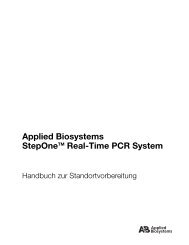
![[PDF] GeneArt® Chlamydomonas Engineering Kits - Invitrogen](https://img.yumpu.com/21960429/1/190x245/pdf-geneartr-chlamydomonas-engineering-kits-invitrogen.jpg?quality=85)
